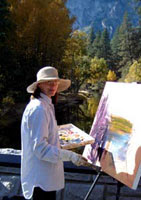 |
| Silkscreen print drying on the line |
After years of being a painter full-time, I began to have an itch to learn a new medium. Don't get me wrong, I am still completely seduced by the buttery allure of oil paint. Being a painter makes it easy to be impulsive, messy, and fickle with your colors. This suits me well.
Silkscreen has made me think about color in a new way, and I am glad for it. I am learning to commit. Once you have decided to use a large field of color, there is little you can do, other than wash your screen out and start over. So you start thinking a lot more before acting. They say making any sort of print is 90% preparation, and 10% action.
Why silkscreen? Well, I knew I wanted to do some sort of handmade printmaking process. I don't believe in making reproductions of my paintings. I wanted to create something more affordable yet also handmade. Woodblock prints were my first inclination, but I am not good with sharp objects. My mother is a printmaker. She tried to get me excited about monoprints. They are more painterly than lithos or etching, but still require a press. Plus, there is just one. How sad!
I've always had a fascination with 19th c. Japanese woodblock prints. This began when I visited Monet's house in Giverny. He was a big collector of woodblock prints, and even had a Japanesque landscaped garden complete with footbridge. It makes sense, really. The idea behind a Japanese tea ceremony is to bring every sense alive, and in a way this is what happens when you go outside to paint. You are still, observing, and letting sensation come to you. Monet's work always spoke to me as a child because of the sincerity in it. He was simply documenting his own experience of the world in a prosaic way. The beauty was incidental. He also made painting look like such fun.
 |
| "Red Lenin" by Any Warhol |
Silkscreen, in my mind, had always been helplessly tied to Andy Warhol, an artist whose commercial work I found slightly annoying. Yes, I saw
Factory Girl, and I get that was a 60's thing. (That movie is terrible, by the way! Poor Bob Dylan.) Anyway, it wasn't until I saw some of his other prints, the less commercial and more off-beat ones, that I started to think he was maybe onto something. I especially like the ones where you can see his Eastern European roots, perhaps because this type of personal reference makes me think an artist is being honest.
Then, I found
Hilary Williams, an artist who was teaching a class on silkscreen, and decided to enroll. Her description was "painterly printmaking", which seemed ideal. Silkscreen work only require a small amount of space as you don't need a press. The screens are not expensive. Most of the work is done with your hands, which gives it a satisfyingly physical feel. My prints are all very painterly, with no two being exactly alike in an edition. I even use paint, Golden's Open series of acrylic paint, to make my images. Traditional printmaking inks are somewhat limited in palette, and also not rated for lightfastness which makes them less archival.
The image below is one of my earlier silkscreens, "The City Nestled in Fog". I started with a very pink sky, then kept adding blue to tone it down. There are usually only 10 prints in an edition, as I can't be bothered with the repetition of doing 25 or even 50 prints. I've seen a lot of those on Etsy and wonder how they manage to do it without going totally nuts! I guess it makes sense financially if you're only going to charge $25. Still, ugh! My arms hurt at the end of a printing day, but at least my head feels great.
 |
| pinker sky |
 |
| bluer sky |


















